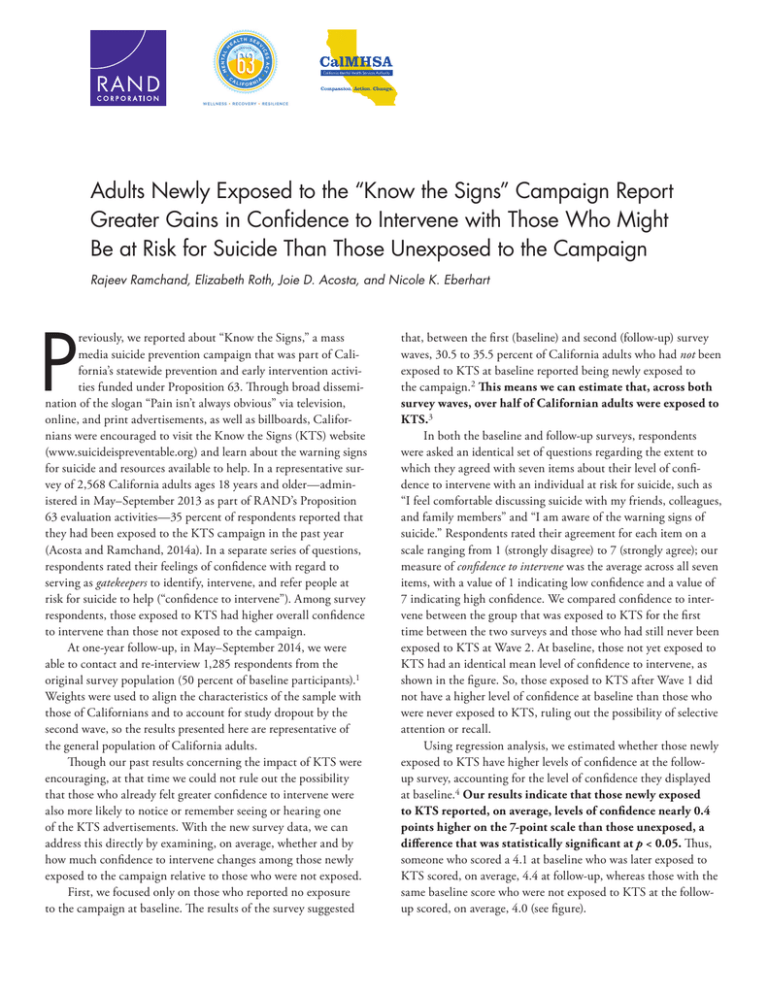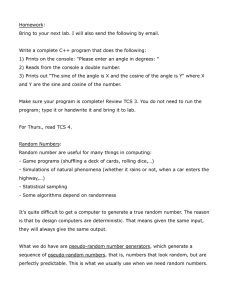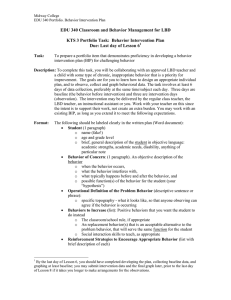Adults Newly Exposed to the “Know the Signs” Campaign Report
advertisement

Adults Newly Exposed to the “Know the Signs” Campaign Report Greater Gains in Confidence to Intervene with Those Who Might Be at Risk for Suicide Than Those Unexposed to the Campaign Rajeev Ramchand, Elizabeth Roth, Joie D. Acosta, and Nicole K. Eberhart P reviously, we reported about “Know the Signs,” a mass media suicide prevention campaign that was part of California’s statewide prevention and early intervention activities funded under Proposition 63. Through broad dissemination of the slogan “Pain isn’t always obvious” via television, online, and print advertisements, as well as billboards, Californians were encouraged to visit the Know the Signs (KTS) website (www.suicideispreventable.org) and learn about the warning signs for suicide and resources available to help. In a representative survey of 2,568 California adults ages 18 years and older—administered in May–September 2013 as part of RAND’s Proposition 63 evaluation activities—35 percent of respondents reported that they had been exposed to the KTS campaign in the past year (Acosta and Ramchand, 2014a). In a separate series of questions, respondents rated their feelings of confidence with regard to serving as gatekeepers to identify, intervene, and refer people at risk for suicide to help (“confidence to intervene”). Among survey respondents, those exposed to KTS had higher overall confidence to intervene than those not exposed to the campaign. At one-year follow-up, in May–September 2014, we were able to contact and re-interview 1,285 respondents from the original survey population (50 percent of baseline participants).1 Weights were used to align the characteristics of the sample with those of Californians and to account for study dropout by the second wave, so the results presented here are representative of the general population of California adults. Though our past results concerning the impact of KTS were encouraging, at that time we could not rule out the possibility that those who already felt greater confidence to intervene were also more likely to notice or remember seeing or hearing one of the KTS advertisements. With the new survey data, we can address this directly by examining, on average, whether and by how much confidence to intervene changes among those newly exposed to the campaign relative to those who were not exposed. First, we focused only on those who reported no exposure to the campaign at baseline. The results of the survey suggested that, between the first (baseline) and second (follow-up) survey waves, 30.5 to 35.5 percent of California adults who had not been exposed to KTS at baseline reported being newly exposed to the campaign.2 This means we can estimate that, across both survey waves, over half of Californian adults were exposed to KTS.3 In both the baseline and follow-up surveys, respondents were asked an identical set of questions regarding the extent to which they agreed with seven items about their level of confidence to intervene with an individual at risk for suicide, such as “I feel comfortable discussing suicide with my friends, colleagues, and family members” and “I am aware of the warning signs of suicide.” Respondents rated their agreement for each item on a scale ranging from 1 (strongly disagree) to 7 (strongly agree); our measure of confidence to intervene was the average across all seven items, with a value of 1 indicating low confidence and a value of 7 indicating high confidence. We compared confidence to intervene between the group that was exposed to KTS for the first time between the two surveys and those who had still never been exposed to KTS at Wave 2. At baseline, those not yet exposed to KTS had an identical mean level of confidence to intervene, as shown in the figure. So, those exposed to KTS after Wave 1 did not have a higher level of confidence at baseline than those who were never exposed to KTS, ruling out the possibility of selective attention or recall. Using regression analysis, we estimated whether those newly exposed to KTS have higher levels of confidence at the followup survey, accounting for the level of confidence they displayed at baseline.4 Our results indicate that those newly exposed to KTS reported, on average, levels of confidence nearly 0.4 points higher on the 7-point scale than those unexposed, a difference that was statistically significant at p < 0.05. Thus, someone who scored a 4.1 at baseline who was later exposed to KTS scored, on average, 4.4 at follow-up, whereas those with the same baseline score who were not exposed to KTS at the followup scored, on average, 4.0 (see figure). –2– Baseline and Follow-Up Levels of Confidence to Intervene Among Those Not Exposed to KTS at Baseline Confidence to intervene 7 6 Not exposed to KTS between baseline and follow-up Exposed to KTS between baseline and follow-up 5 4.1 4 4.4 4.0 3 2 1 RAND RR1134 Baseline score Follow-up score among those scoring 4.1 at baseline As important as it is to understand whether this effect of new exposure occurs in different racial/ethnic groups and among those who took the survey in a language other than English, our sample sizes were not large enough to detect meaningful differences among diverse groups of Californians. Results from our previous evaluation of the KTS media campaign materials found that it aligned with best practices and was highly regarded by experts (Acosta and Ramchand, 2014b). We also found that those exposed to the campaign at baseline had higher levels of confidence in their ability to intervene with someone in distress (Acosta and Ramchand, 2014a). The second wave of survey data enabled us to examine changes in confidence among those subsequently exposed to the campaign compared with those who were never exposed. The results presented here provide further evidence that the KTS campaign is making Californians more confident in their abilities to intervene with someone at risk of suicide. Notes As with all longitudinal surveys, those lost to follow-up may differ systematically from those who agreed to be re-surveyed. This may bias results, in that those who completed the follow-up survey may have been more likely to have been exposed to KTS, experienced greater changes in confidence to intervene, or both. 1 Our measure of exposure to KTS was the same as reported in Acosta and Ramchand, 2014a: Respondents were asked if they had, in the past 12 months, “seen or heard an advertisement that has the slogan ‘Know the Signs’ or ‘Pain Isn’t Always Obvious’ or ‘Suicide Is Preventable,’” “visited the website ‘Suicide Is Preventable dot org,’” or “seen or heard an advertisement for suicide prevention with the website ‘Suicide is Preventable dot org.’” Respondents reporting “yes” to any of these questions were categorized as having been exposed to KTS. 2 3 35 percent at baseline + 33 percent newly exposed among 65 percent of those unexposed at baseline = 56.45 percent. Among those with no exposure at baseline, our regression model took the form Y2 = β0 + β1Y1 + β2 X, where Y is level of confidence and X is exposure to KTS, as reported at the follow-up survey. The results from this model were β0 = 2.26, β1 = 0.43, and β2 = 0.39. 4 References Acosta, Joie, and Rajeev Ramchand, Adults Exposed to “Know the Signs” Are More Confident Intervening with Those At Risk for Suicide, Santa Monica, Calif.: RAND Corporation, RR-686-CMHSA, 2014a. As of May 6, 2015: http://www.rand.org/pubs/research_reports/RR686.html Acosta, Joie, and Rajeev Ramchand, “Know the Signs” Suicide Prevention Media Campaign Is Aligned with Best Practices and Highly Regarded by Experts, Santa Monica, Calif.: RAND Corporation, RR-818-CMHSA, 2014b. As of May 6, 2015: http://www.rand.org/pubs/research_reports/RR818.html Acknowledgments The RAND Health Quality Assurance process employs peer reviewers. This document benefited from the rigorous technical reviews of Joshua Breslau and Donna Farley, which served to improve the quality of this report. In addition, members of the Statewide Evaluation Experts (SEE) Team, a diverse group of California stakeholders, provided valuable input on the project. RAND Health This research was conducted in RAND Health, a division of the RAND Corporation. A profile of RAND Health, abstracts of its publications, and ordering information can be found at http://www.rand.org/health. CalMHSA The California Mental Health Services Authority (CalMHSA) is an organization of county governments working to improve mental health outcomes for individuals, families, and communities. Prevention and Early Intervention programs implemented by CalMHSA are funded by counties through the voter-approved Mental Health Services Act (Prop. 63). Prop. 63 provides the funding and framework needed to expand mental health services to previously underserved populations and all of California’s diverse communities. © Copyright 2015 RAND Corporation www.rand.org The RAND Corporation is a nonprofit institution that helps improve policy and decisionmaking through research and analysis. RAND focuses on the issues that matter most, such as health, education, national security, international affairs, law and business, the environment, and more. As a nonpartisan organization, RAND operates independent of political and commercial pressures. We serve the public interest by helping lawmakers reach informed decisions on the nation’s pressing challenges. RAND’s publications do not necessarily reflect the opinions of its research clients and sponsors. R® is a registered trademark. RR-1134-CMHSA CHILDREN AND FAMILIES EDUCATION AND THE ARTS The RAND Corporation is a nonprofit institution that helps improve policy and decisionmaking through research and analysis. ENERGY AND ENVIRONMENT HEALTH AND HEALTH CARE INFRASTRUCTURE AND TRANSPORTATION This electronic document was made available from www.rand.org as a public service of the RAND Corporation. INTERNATIONAL AFFAIRS LAW AND BUSINESS NATIONAL SECURITY POPULATION AND AGING PUBLIC SAFETY SCIENCE AND TECHNOLOGY TERRORISM AND HOMELAND SECURITY Support RAND Browse Reports & Bookstore Make a charitable contribution For More Information Visit RAND at www.rand.org Explore the RAND Corporation View document details Research Report This report is part of the RAND Corporation research report series. RAND reports present research findings and objective analysis that address the challenges facing the public and private sectors. All RAND reports undergo rigorous peer review to ensure high standards for research quality and objectivity. Limited Electronic Distribution Rights This document and trademark(s) contained herein are protected by law as indicated in a notice appearing later in this work. This electronic representation of RAND intellectual property is provided for noncommercial use only. Unauthorized posting of RAND electronic documents to a non-RAND website is prohibited. RAND electronic documents are protected under copyright law. Permission is required from RAND to reproduce, or reuse in another form, any of our research documents for commercial use. For information on reprint and linking permissions, please see RAND Permissions.




